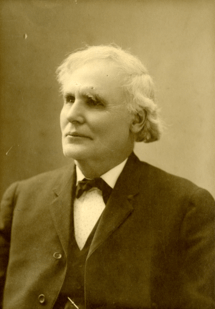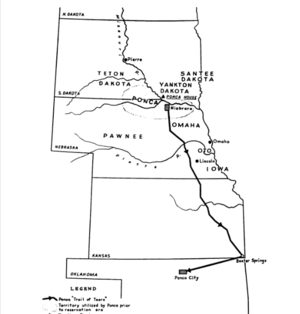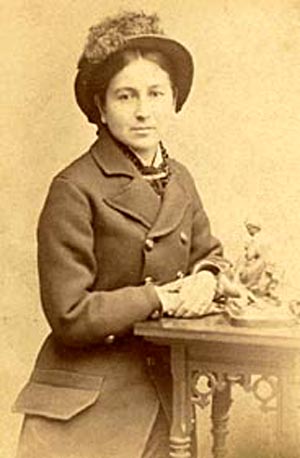Thomas Tibbles facts for kids
Quick facts for kids
Thomas Tibbles
|
|
|---|---|
 |
|
| Personal details | |
| Born | May 22, 1840 Washington County, Ohio, U.S. |
| Died | May 14, 1928 (aged 87) Omaha, Nebraska, U.S. |
| Political party | Populist |
| Spouse |
Amelia Owen
(m. 1861; died 1879)Ida Belle Riddle
(m. 1907) |
Thomas Henry Tibbles (born May 22, 1840 – died May 14, 1928) was an important American figure. He was against slavery, a writer, a journalist, and a politician. He also worked hard to protect the rights of Native Americans. Tibbles was born in Ohio and lived in many places, especially Nebraska.
He played a key role in the famous trial of Standing Bear in 1879. This court case helped the Ponca tribe gain freedom from their forced home in Oklahoma. This important legal victory led to better civil rights for Native Americans across the United States.
Contents
Thomas Tibbles' Early Life
Thomas Tibbles was born on May 22, 1840, in Ohio. When he was 14, he moved to Iowa to study law. At 16, he joined a group fighting against slavery called the Free-State Militia. This group was led by James H. Lane.
Later, Tibbles joined another group led by John Brown. He fought in many battles during the "Bleeding Kansas" conflict. This was a fight about slavery on the border between Kansas and Missouri. Tibbles was captured by groups who supported slavery and was sentenced to die. But he managed to escape. After the fighting ended, he spent time with the Omaha tribe. He even joined them in a fight against the Sioux.
After his time as a soldier, Tibbles studied at Mt. Union College in Ohio. This was from 1858 until the U.S. Civil War began in 1861. On October 1, 1861, he married his first wife, Amelia Owen. They had two daughters, Eda and May. During the war, Tibbles worked as a scout for the Union army in Kansas and Missouri. He helped break up groups of horse thieves. He was captured once but was rescued by his friends. By the end of the war, Tibbles became a Major. He also wrote for newspapers during the war. This was the start of his long career in journalism.
Tibbles once wrote about himself that he "preferred not to be educated." He also said he had many scars from gunshots and other wounds. He was known as one of the best revolver shooters in the West.
Thomas Tibbles' Career Path
From Preacher to Journalist
After the war, Tibbles used his religion classes from college to become a Methodist preacher. He rode a horse around Missouri and Nebraska, preaching to people. He carried a gun while he preached. Later, he became a Presbyterian and built a church in Omaha.
In 1874, Tibbles saw that many people in Nebraska were starving. This was because of a drought and bad crops. He helped raise over $80,000 to help these people. He did this by giving speeches and asking for donations. He also worked for newspapers in Omaha while preaching. In 1877, Tibbles stopped being a preacher. He wanted to work full-time for social justice through journalism.
Becoming a Reporter
Tibbles first worked for the Omaha Daily Bee. Then he joined the Omaha Daily Herald and became the assistant editor. This is where he was working when something very important happened. On March 30, 1879, General George Crook came to him. The General told Tibbles about the serious problems facing the Ponca Native Americans.
The Standing Bear Trial
The Ponca Tribe's Difficult Journey
As assistant editor of the Omaha Daily Herald, Tibbles helped bring the case of Standing Bear and the Ponca people to court. This happened in the United States District Court at Fort Omaha in 1879. The U.S. government had broken a treaty. They mistakenly gave the Ponca's land in Nebraska to the Sioux tribe. This forced the Ponca to walk about 500 miles south to Oklahoma.
Chief Standing Bear said that his people struggled to survive in the Indian Territory. The Omaha tribe, who were related to the Ponca, offered them good land. But the government would not let the Ponca take it. Many Ponca people died from sickness, bad weather, and not enough help from the government. About one-third of the tribe died in two years. Chief Standing Bear sadly said, "We had nothing to do but sit still, be sick, starve, and die."
How Tibbles Got Involved
Tibbles met Chief Standing Bear on March 30, 1879. The Chief and about 30 Ponca people had been arrested. They were held because they left the Oklahoma territory to return to their old lands. General George Crook did not agree with the order to arrest them. He secretly met with Tibbles and asked him to help the Ponca. General Crook said Tibbles was the only one who could save them. Chief Standing Bear wanted his land back. He also wanted tools like "plows and axes and wagons." Most importantly, he wanted a legal promise that their land would never be taken again.
Tibbles decided to help the Ponca people. He started telling their story in major newspapers. This helped people learn about the Ponca's difficult situation. Susette La Flesche, a well-educated Omaha interpreter, also helped. She spoke to church groups and raised awareness. Because of their efforts, Chief Standing Bear got free lawyers for his court case. The case also gained national attention.
John L. Webster and A.J. Poppleton were the lawyers for Chief Standing Bear. They filed a legal paper called a writ of habeas corpus. This paper asked the court to decide if the Ponca were being held illegally. The court heard their case for two days, starting on April 28, 1879, at Fort Omaha.
The Court Case
The government argued that Native Americans were not "persons" under U.S. law. They said Native Americans did not have basic rights like citizens. This meant they could not sue the government. The government also claimed that their rules were not truly stopping the Ponca's way of life.
The lawyers for Chief Standing Bear argued that the Ponca were trying to live like white settlers. They were farming and following U.S. laws. The lawyers said that the Ponca should be considered citizens. They pointed to the 14th Amendment, which had just been added to the Constitution.
The Court's Decision
Judge Elmer Dundy ruled in favor of Chief Standing Bear. He decided that American Indians did have the rights of citizens. He said that Indians had the right to sue the government. He also said the U.S. Army had no right to take them from their land. Judge Dundy ordered the immediate release of the 30 Ponca people held at Fort Omaha.
Most importantly, the judge declared that "An Indian is a PERSON within the meaning of the laws of the United States." He also said they had the right to "life, liberty and the pursuit of happiness" as long as they followed the law. Tibbles continued to fight for Native American rights for the rest of his life. This work became his lasting legacy.
Thomas Tibbles' Political Life and Later Years
After the Standing Bear Trial
After the trial, Thomas Tibbles kept working for equal treatment for Native Americans. In the summer of 1879, he went on a speaking tour. He visited Chicago and Boston. He told people about the Ponca's problems and the problems of other tribes in Nebraska. He also worked to get Native Americans citizenship.
He then went on another tour with Chief Standing Bear, the Chief's son, and his daughter, Bright Eyes. Bright Eyes had helped interpret for Chief Standing Bear at the trial. This tour included Chicago, Boston, and New York City. While on this trip, Tibbles learned that his wife had suddenly died. In 1880, Tibbles published his first book, The Ponca Chiefs: An Account of the Trial of Standing Bear. He used the pen name "Zylyff."
Thomas Tibbles and Susette La Flesche married on June 29, 1881. That same year, Tibbles published his second book, Hidden Power, under his own name. They first lived in Omaha on a farm. Both Tibbles and his new wife continued to give lectures in 1882-83. They successfully convinced Congress to give the Omaha tribe individual land plots. However, some tribe members were not happy with how the land was divided. From 1883 to 1885, they moved to Washington D.C. There, they continued to speak about Native American issues. They also went on a speaking tour in England and Scotland in 1886.
In 1888, Tibbles returned to work as a reporter for the Omaha World Herald. In 1890, he visited Pine Ridge Agency. He was an eyewitness to the terrible Wounded Knee event. He reported this tragedy to the world. He continued to work as a journalist for many newspapers. He was also a Washington correspondent from 1893 to 1895.
Populism and Vice-Presidential Nomination
After his work in Washington, Tibbles returned to Nebraska. He became very involved in the Populist movement. He became the editor-in-chief of The Independent, a weekly Populist newspaper. He became more and more active in the Populist movement. In 1904, he was chosen to run for Vice-President on the Populist ticket. However, his party did not win the election. This happened a year after his wife Susette died in 1903.
After the Election
In 1905, Tibbles wrote his third and final book, Buckskin and Blanket Days. This book was about his own life. In 1907, he married his third wife, Ida Belle Riddle. He continued to be active in the Populist movement. He edited other newspapers for the party from 1905 to 1910. After that, he returned to the Omaha World Herald until he retired in 1928. Thomas Tibbles died on May 14, 1928. He was buried in Bellevue Cemetery in Nebraska, and Ida was later buried next to him.
Images for kids





